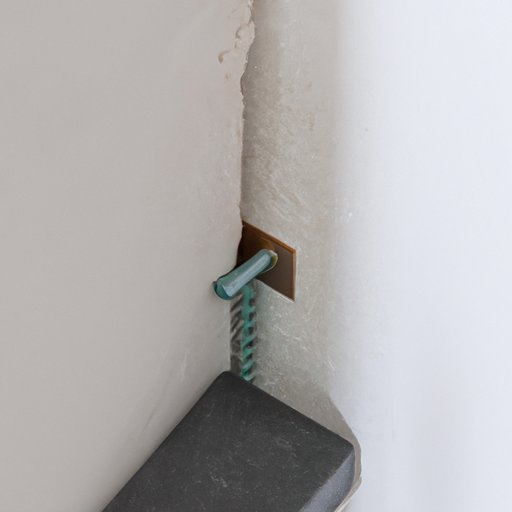
Introduction
Drywall anchors are a necessary component for hanging items on hollow walls. Whether you’re decorating your home or office, a drywall anchor is vital to ensure your item is securely in place. However, many people often wonder how much weight a drywall anchor can hold. This article aims to answer that question and provide valuable information on how to choose the right anchor for your hanging needs.
The Ultimate Guide to Understanding Drywall Anchors: How Much Weight Can They Really Hold?
Drywall anchors are small but crucial tools for hanging items on a hollow wall. They come in different shapes, sizes, and materials, and are designed to secure screws and hooks in place. They’re incredibly durable and reliable but can only withstand a certain amount of weight. This guide aims to provide you with a comprehensive understanding of drywall anchors and their weight limits to help you make an informed decision when choosing an anchor for your next hanging project.
Breaking Down the Numbers: What You Need to Know About Drywall Anchor Weight Limits
Different types of drywall anchors have different weight limits. Nonetheless, most wall anchors can hold up to 50 pounds of weight. Here is a breakdown of the weight limits for each type of anchor:
- Plastic expansion anchors – 5 to 25 pounds of weight
- Winged plastic anchors – 25 to 35 pounds of weight
- Threaded drywall anchors – 25 to 50 pounds of weight
- Metal toggle anchors – 50 to 75 pounds of weight
In addition, weight limits can also be affected by the wall type and the installation technique. A thicker and sturdy wall will be able to support more weight, while an older and weaker wall will support less weight. Therefore, it’s essential to select a suitable wall anchor for your wall type, so you don’t damage the wall or risk your item falling down.
From Light to Heavy: Matching Your Hanging Needs to the Right Drywall Anchor
Before selecting a drywall anchor, it’s essential to determine the weight of the item you want to hang. You can do this by reading the manufacturer’s weight guidelines or using a weighing scale to determine the weight of the object. Once you know the object’s weight, you can match it to the right anchor type.
For lighter objects such as picture frames, plastic expansion anchors or winged plastic anchors are sufficient. However, heavier objects such as mirrors, shelves, and TV mounts require stronger anchors such as metal toggle anchors or threaded drywall anchors. Here are examples of different items and the corresponding drywall anchor types:
- Picture frames – Plastic expansion anchors
- Small shelves – Winged plastic anchors
- Mirrors – Threaded drywall anchors
- TV mounts – Metal toggle anchors
The Science of Load Capacity: Exploring the Factors That Affect Drywall Anchor Strength
The load capacity of a drywall anchor depends on several factors that are essential to understand. Load capacity refers to the maximum weight the anchor can hold without breaking or damaging the wall. One of the critical factors that influence load capacity is weight distribution. If the weight is distributed evenly across the anchor, it can hold more weight. However, if the weight is concentrated at only one point, it could damage the anchor and the wall. It’s recommended to distribute the weight evenly across the anchor to maximize the load capacity.
The type of wall material also affects the load capacity. If your wall is softer, then a plastic anchor would be suitable for light to medium weight items. But if your wall is robust, then a metal anchor would be appropriate for heavier items. Metal anchors are better suited for heavier items because they provide a more secure grip on the wall.
Going Beyond the Box: Expert Tips for Testing and Maximizing Drywall Anchor Weight Limits
Before hanging any item on a drywall anchor, it’s essential to perform a test to ensure the anchor can hold the weight of the object. A simple test would be to hang a small object on the anchor and see if it holds in place. If it does, you can be assured that the anchor can hold the weight of the item you want to hang.
Maximizing the weight limits of drywall anchors is essential, especially when hanging heavy items. One of the best ways to accomplish this is by drilling a pilot hole slightly smaller than the anchor’s diameter. Doing this ensures a tight and secure fit, which increases the anchor’s holding strength. Additionally, push the anchor in as far as possible to ensure maximum hold and security.
The Truth About the Most Common Myths Surrounding Drywall Anchor Weight Limits
There are many myths surrounding drywall anchors and their weight limits that people believe. Some of the most common ones include:
- Plastic anchors are weaker than metal anchors.
- Drywall anchors always damage the wall.
- Threaded anchors provide better grip and support than metal toggle anchors.
These are misconceptions that have been debunked by research and practical experience. Plastic anchors can hold a significant amount of weight, and metal toggle anchors are secure enough to hold heavy objects. However, it’s essential to ensure you select the correct anchor and installation technique for your wall type and hanging needs.

Hack Your Hanging Projects: Creative Ways to Use Drywall Anchors for Maximum Weight Support
If you’re in need of a creative solution to hang heavy items on a hollow wall, here are some hacks to consider:
- Use multiple anchors – By using multiple anchors spaced evenly across the width of the object, you can distribute the weight evenly, increasing the load capacity.
- Use butterfly anchors – Butterfly anchors are an excellent choice for hanging heavier objects on a wall. They’re easy to install and provide maximum support at the same time.
- Use a drywall anchor drill bit – A drill bit made specifically for drywall anchors can make installation easier and quicker. It ensures the anchor is properly aligned and installed for maximum support.
When trying out new hanging techniques, it’s important to follow the manufacturer’s instructions and test the anchor’s strength before hanging your item.
Conclusion
Knowing how much weight a drywall anchor can hold is crucial to ensure your hanging project is secure and safe. By using the information and tips provided in this guide, you can select the right anchor for your wall type and hanging needs. Remember to test the anchor strength before hanging your item, and never exceed the maximum weight limit recommended by the manufacturer. With the right anchor and installation technique, you can hang your favorite items on a hollow wall with confidence.





